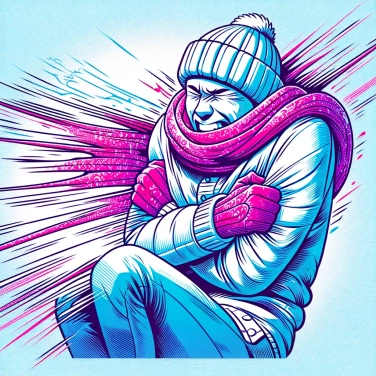Cold can cause shivering because our bodies react by producing more heat through muscle contractions to maintain a stable internal temperature.

Our skin contains small specialized sensors called thermoreceptors, true temperature detectors. Those that react to cold are located just beneath the surface of the epidermis. As soon as the temperature drops, they activate, immediately sending an alert message to the brain via the nerves. This information is quickly interpreted as a potentially dangerous drop in temperature. The body then reacts by triggering various responses to protect the internal organs. These cold-sensitive sensors are particularly numerous in certain areas, such as the face or hands, which explains why these parts feel the temperature change even more rapidly.
A shiver is a rapid and involuntary series of muscle contractions, usually accompanied by a feeling of trembling. When we are cold, the body activates these little tremors to immediately generate heat by moving our muscles very quickly, thus maintaining our body temperature around 37°C. This phenomenon is therefore a kind of reflex of our organism in response to the cold. We can't really control it; it happens spontaneously, in order to warm us up as efficiently as possible.
It all starts with small sensory receptors located under your skin. When it’s cold, these receptors quickly send nerve signals to your hypothalamus, a small region of your brain that acts like a true natural thermostat for the human body. The hypothalamus analyzes the information and reacts quickly by triggering an automatic response transmitted through your nervous system. As a result, your muscles begin to activate without you really realizing it, making rapid small contractions called shivering reflexes. These repeated nerve contractions are mostly managed without your conscious control, involving nerve pathways from your spinal cord. This mechanism helps generate a little more body heat quickly to maintain your organism at the right temperature.
When it's cold, your body has an original trick: the shiver. This thing is a straightforward reaction to quickly produce some heat. In practice, your muscles move very quickly in an involuntary way, causing rapid little contractions. The result: this movement generates heat and helps maintain the ideal internal temperature of around 37°C. It's a bit like your body suddenly deciding to make you shiver just to urgently turn on the biological heating. Not very convenient for comfort, but honestly clever for survival.
In response to the cold, your body will quickly react: the blood vessels located under your skin constrict to keep warm blood close to essential organs. This already explains why your fingers and nose feel cold when it’s cold outside. Next, your muscles will start to undergo rapid and involuntary contractions (shivering). These muscle contractions generate heat to warm up your whole body. Basically, it’s your own internal furnace that kicks in to prevent you from ending up frozen like an Eskimo!
Researchers have found that cold not only causes shivering but also increases the production of certain hormones such as adrenaline; a physiological mechanism that helps to quickly release energy to generate heat.
Shivers are not solely caused by cold. They can also be triggered by strong emotions or even fever, as the mechanism of shivering is primarily a reflex controlled by the brain.
Did you know that some animal species have their own equivalent of shivering to fight against the cold? For example, birds fluff up their feathers to create an insulating layer of warm air around their bodies.
When the body shivers, the muscles contract and thus generate body heat. This mechanism, similar to that of an idling engine, can temporarily increase the body's usual heat production by up to five times.
Cold sensitivity and the frequency of shivering can vary from person to person, depending on various factors such as body mass, the amount of insulating fat, individual metabolism, or even peripheral blood circulation. Elements such as age or certain pathological conditions can also influence this sensitivity.
In general, shivers are an automatic response of the body, controlled by the autonomic nervous system, making them very difficult to consciously control. However, it is possible to reduce their frequency and impact by adopting effective thermoregulation habits, such as wearing clothing suitable for the climate, engaging in regular physical exercise, and maintaining good hydration.
Sure! Here’s the translation: "Yes, other factors besides cold can trigger shivering. Intense emotions, such as fear or excitement, as well as fever or certain infectious diseases, can also cause shivering. This reaction is linked to the autonomic nervous system, which responds to various situations."
In general, chills related to moderate exposure to cold are normal and not concerning. However, if the chills persist for a long time despite proper protection, or if they are accompanied by fever, pain, or unusual symptoms, it is advisable to consult a healthcare professional, as this may be a sign of infection or hypothermia.
Goosebumps occur when small muscles at the base of our hairs (called arrector pili muscles) contract due to cold, causing the hairs to stand up. This is an ancestral reflex designed to insulate the body from the cold by creating an insulating layer of air on the skin. Although this is not very effective in humans today, it is a remnant of our evolutionary past.

No one has answered this quiz yet, be the first!' :-)
Question 1/5